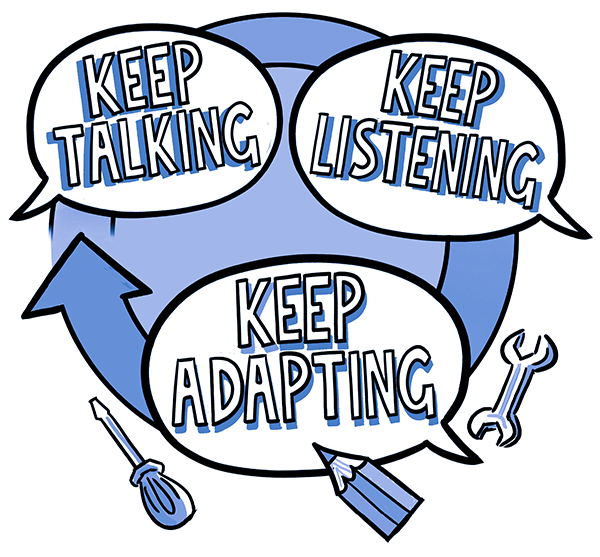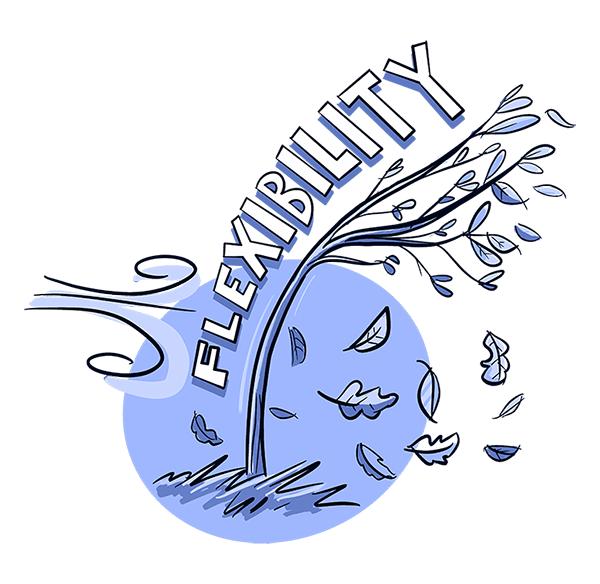Effective Methods
Emerging from Explore Your Universe came a number of methods for working with diverse and under-served audiences. These strategies may not be applicable to all audiences, but they can be used to understand what level and balance of co-production was found to be most suitable here, to help set expectations when engaging with community partners in this context, particularly for the first time.

Distribute a range of items and/or activities around the space. Allow participants to explore on their own terms and in any order. The activities they gravitate towards and enjoy can provide insight to guide the development and structure of future sessions.
Be sure to engage informally with participants. Get to know them and take their interests on board. You might want to visibly take notes to capture their feedback and suggestions.
This strategy is particularly successful when engaging with a particular topic where the content is unfamiliar to many children. For example, asking what area of STFC science the students are interested in exploring was unlikely to be fruitful in Explore Your Universe.
A blank sheet of paper can work if facilitated really well or led by your community partner, but it can also be overwhelming and too broad. Similar to being asked to pick any song for a playlist (your mind goes blank or you may be worried about saying the wrong thing) there are many reasons why a blank-sheet-of-paper or a completely open-question approach isn’t often the best opener.
I'm doing proper science!
Participant, partnership with Xplore! Science Discovery Centre
Learning from the wider sector
The Horizon2020 EU Funded programme ‘Our Space Our Future’ also embedded co-production in partnership work with schools. Delivery partners reported:
“We didn’t have a lot of time, but wanted to work with their interests. Given complete freedom
and a blank sheet, they of course worked with what they knew already: the Moon, Mars, maybe Uranus! But we rarely explored further, so we introduced a section with multiple choice. They could still be in the driving seat, but now have the opportunity to explore a black hole or vote for an astrobiologist as their favourite space career rather than an astronaut.”
This problem is summed up in this quote from a participant at We The Curious, Bristol when visiting the café as part of their Curious Researchers project:
I like apple juice, but if I knew orange juice was an option, I might have chosen that instead.
“What would you like to do next?”
This simple question is more of a consultation level of co-production (or ‘co-development-lite’ as one practitioner termed it) but it is still very valuable to deepen relationships and is far more collaborative than simply delivering a pre-set series of activities. Your willingness and enthusiasm to draw on the interests of your participants and the expertise of your community partner will strengthen the activity you offer.
TOP TIP
Provide a menu of options that participants can choose from based on their interests. Multiple choice options, along with ways to make these choices engaging and anonymous, can help bring out the interests of group members who wouldn’t otherwise put themselves forward. Why not try using live polls like Slido or Mentimeter etc, or get hands on with Plickers for the vote?
I also really liked having the big paper board that I could just write down on because it showed that I was listening to them... next time, I'd bring back that board and go "here's what you wanted to look at, here's what we're doing.
Practitioner, Techniquest
TOP TIP
When the activities take place, if it is not obvious, emphasise areas where feedback has been taken on board to clearly demonstrate to participants that their ideas were heard and valued. Relationships flourish when partners or participants can clearly identify elements where they have had input.

Building a rapport
Closely tied to building trust, create opportunities to ask questions or have casual chats, whether around food, during breaks or during activities, to gain wonderful insights into participants’ interests and experience of science and what they already value about it.
Not only does this help you get to know them individually, but it can also help you understand what they experienced from the engagements, what worked and what could be improved.
Building relationships and trust is particularly important when working with young people who may have had adverse childhood experiences. They may have been excluded from similar positive learning experiences previously, have a mistrust of authority or innate responses that are deep seated and cause unpredictable behaviours for those who don’t know them. So always value the experience of your community partner.
Case Study from Explore Your Universe
Taking a ‘co-development-lite’ approach Aberdeen Science Centre first proposed a set of activities to their community partner (Fersands and Fountain Community Project). On agreement, and once the initial activity took place, the two partners reflected together and Aberdeen Science Centre took on board the feedback from their partner to inform the following engagement.
The partnership progressed in this way, leading to a series of successful experiences for the young people involved and leaving both Aberdeen Science Centre and Fersands and Fountain Community Project feeling like the experience had been truly collaborative.
TOP TIP
In all cases, reflection with your community partner – formal or informal – should take place. This can then feed into the development of future engagements. Reflection can be as easy as a brief chat over the phone. Ask the questions:
What was a really good moment?
What was challenging?
and What learning can we take from this?
Learning from outside the sector
“If something isn’t working - modify, change strategy and stay flexible. Stay real, visual and multi-sensory. And above all, you need to be a people person and develop a rapport with the students. Be quick to make those connections and find common ground. This is quite critical to building a relationship.”
Science Lead, Notton House Academy (specialised in working with young people with Special Educational Needs and Disability and trauma-informed teaching).
That kind of openness, asking the question, stating what we have that they can use, but also listening... if there's a whole bunch of people who are saying 'we'd really like thing Y', OK maybe we need to actually think about that because that's something that is going to be useful.
Practitioner, Cambridge Science Centre
Case Study from Explore Your Universe
A group of young people created an edition of Cambridge Science Centre’s ‘Open Up Science’ magazine. In this case, the theme of the magazine chosen by the participants was ‘animals’, and pairs of young people worked together to develop pages for the magazine. Although ‘animals’ did not fall neatly under the umbrella of STFC science, Cambridge Science Centre practitioners knew that the best way to inspire participation was to allow the young people freedom to choose the theme. Then, using their expertise, they could build a narrative into the activity that linked back to STFC science.
TOP TIP
Many of the strongest examples of co-production start with openness and questioning, which is something that can easily be adopted by science centres, museums, researchers and other STEM practitioners embarking on this kind of work.

Having objectives but no preconceptions of what your participants should be interested in, involves fleshing out a plan as you go, through interactions with your community and/or your community partner.
Deeper levels of co-production, where the creation, development and delivery is also led by the participants, is likely to take your engagement or research ideas in new and unplanned directions, so be prepared to get out of your comfort zone and let go of the control!
Heading towards an ‘end product’
Working towards a shared goal or ‘end product’ with your community partner can steer the activity in the right direction and give participants a reinforced sense of ownership, agency and pride. An ‘end product’ could be an activity, a tangible output such as a physical object or exhibit (e.g. a zine, drawing or fabricated item) or a celebration to signify the end of the project.
Supporting autonomy and agency
A key aspect of co-production is supporting the autonomy and agency of participants. Whether you reflect on a previous workshop to inform the next, consult participants about what they would like to do, make changes during the course of a workshop, or direct activities towards a clear ‘end product’, the significant aspect of all these strategies is building a feeling of ownership into the activities and supporting participants to actively contribute and participate on their own terms.
